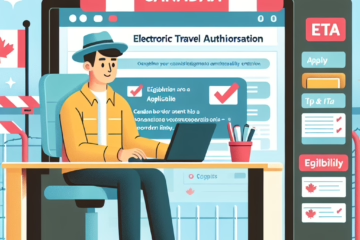Whether it is the scenic beauty, the friendly locals, or the promise of a robust healthcare system, there is a certain allure about Canada that has captivated the hearts of many tourists. Temporary stays can often leave visitors yearning for permanent residence in Canada. If you are one of those people contemplating making this transition, this article will serve as your comprehensive guide. Our aim is to help you navigate Canadian immigration policies and successfully make the shift from a tourist visa holder to a proud permanent resident.
Table of contents
- Understanding Canadian Immigration: The Basics
- Requirements for Visa Transition
- Navigating Immigration Laws and Policies
- The Transition Process: Step-by-Step Guide
- Potential Obstacles and How to Overcome Them
- Legal Assistance and Helpful Resources
- Concluding Your Journey: From Visitor to Citizen 🍁
- Frequently Asked Questions (FAQs)
- What if my tourist visa expires while my permanent residency application is in process?
- Can I work in Canada while I’m waiting for my permanent residency?
- Is there a way to speed up the application process for permanent residency?
- What happens if my application for permanent residency is denied?
- Can I apply for a change to permanent residency if I entered Canada without a visa (visa-exempt)?
Understanding Canadian Immigration: The Basics

Canada, known for its welcoming nature and multicultural society, offers several paths to permanent residency. The key is to understand that the process isn’t one-size-fits-all, and the route you take will depend on various factors such as your skills, work experience, and family ties.
Different Paths to Permanent Residency
There are numerous pathways to permanent residency in Canada, including the Federal Skilled Workers Program, Canadian Experience Class, and Family Sponsorship. Then there’s the Provincial Nominee Program, which offers promising opportunities for individuals with skills in demand in specific provinces.
However, what do these pathways mean for a tourist visa holder? Primarily, it means you have options, and your tourist visa is just the beginning of your journey. While transitioning directly from a tourist visa to permanent residency isn’t typically the standard process, certain circumstances and qualifications can make it possible.
Role of a Tourist Visa in Immigration
A tourist visa, officially known as a Visitor Visa or Temporary Resident Visa (“TRV”), is generally intended for short-term stays for tourism, visiting family or friends, or business meetings. While a TRV does not directly lead to permanent residency, it does offer the opportunity to experience Canada firsthand and determine if a long-term commitment is right for you.
If you are already in Canada on a tourist visa, you can extend your stay or change your status to a student or worker visa, which can be stepping stones towards permanent residency. However, it is important to note that any attempt to transition should be backed by genuine intent and a proper understanding of Canadian immigration laws.
Key Takeaway: Understanding the basics of Canadian immigration is crucial for your transition from a tourist visa to permanent residency. There are multiple paths to permanent residence, and a tourist visa could be your first step toward exploring these options. However, it’s essential to be well-acquainted with immigration laws to ensure a smooth and lawful transition.
Requirements for Visa Transition
When considering the switch from a tourist visa to permanent residency in Canada, it is crucial to understand the eligibility requirements. Canada uses a points-based system for immigration where applicants are assessed on factors like age, language proficiency, education, and work experience.
Age, Language, and Education
In general, younger applicants tend to score higher in the points-based system. Language proficiency in English or French is key as it impacts your ability to integrate into Canadian society and adds to your overall immigration points.
Canada values education, so higher education degrees can greatly enhance your score. The Educational Credential Assessment (“ECA”) is often required to verify that your educational degree, diploma, or certificate is valid and equivalent to a Canadian one.
Work Experience and Skills
Your work experience and skills significantly affect your eligibility for permanent residency. Canada has a strong demand for skilled workers. If you have experience in a field that is in demand in Canada, it can make your transition smoother. The National Occupational Classification (“NOC”) code is a tool to classify jobs and skills and is often used in the immigration process.
Financial Stability
Lastly, financial stability is key. You must show that you can support yourself and your family in Canada. The exact amount may vary, but you need to meet the necessary financial requirements.
Key Takeaway: The eligibility criteria for transitioning to permanent residency revolves around age, language proficiency, education, work experience, and financial stability. It’s important to assess where you stand in these areas to gauge your likelihood of a successful transition. Use the Comprehensive Ranking System (CRS) tool to calculate your CRS score.
Eligibility Requirements Overview
| Eligibility Criteria | Details |
|---|---|
| Age | Younger applicants tend to score higher on Canada’s immigration points system. |
| Language Proficiency | Applicants must demonstrate proficiency in English or French with an approved language test like IELTS or TEF. |
| Education | Higher education degrees will positively impact the points score. An Educational Credential Assessment (ECA) may be required to verify foreign qualifications. |
| Work Experience | Qualifying work experience, especially in in-demand occupations, as per National Occupational Classification (NOC). |
| Financial Stability | Proof of funds to support oneself and any dependents after moving to Canada. |
| Admissibility | Applicants must not have serious health issues or criminal convictions that would make them inadmissible. |
| Connection to Canada | Having family or a valid job offer in Canada can enhance eligibility. |
| Intention to Reside | Applicants must intend to reside outside the province of Quebec (unless applying through a Quebec program). |
| Adaptability | Points may be awarded for factors like a spouse’s language ability, Canadian work or study experience, or a relative in Canada. |
- Consult with Pax Law Immigration lawyers here.
Navigating Immigration Laws and Policies
It is important to stay updated with immigration laws and policies in Canada. These laws are subject to change and can significantly impact your application process. We will now examine some legal considerations and recent changes.
Legal Considerations for Visa Transition
Firstly, we will clarify a common misconception: simply being present in Canada as a tourist does not automatically make you eligible for permanent residency. Applying for permanent residency while on a tourist visa can be seen as misrepresentation if you initially stated that your intention was for a short stay. Misrepresentation can lead to serious consequences, including a ban from entering Canada for up to five (5) years.
However, there are circumstances where the transition can happen lawfully. For instance, if you marry a Canadian citizen or become a common-law partner of a Canadian citizen, you may apply for sponsorship. Additionally, if your skills and experience match a labour market shortage, you may have an opportunity for visa transition.
Recent Changes in Immigration Policies
Keeping track of changes in immigration policies is crucial as new policies could create new opportunities. For example, due to the pandemic, Canada introduced temporary policy measures to allow visitors to apply for a work permit without having to leave the country, potentially opening a new path to permanent residency.
Key Takeaway: Navigating immigration laws and policies is crucial to your journey toward permanent residency. Awareness of legal considerations and staying updated with policy changes is vital. Be sure to consult with an immigration lawyer or trusted immigration consultant to help guide your unique situation.
The Transition Process: Step-by-Step Guide
Understanding the mechanics of the visa transition process can ease your journey toward obtaining permanent residency in Canada. We will now provide a step-by-step breakdown of the process:
Application Procedure
The application procedure involves careful preparation and patience. The process usually begins with expressing your interest in immigrating to Canada by creating an Express Entry profile. Here, you provide details about your skills, work experience, language ability, education, and other information required for assessment.
If you meet the eligibility criteria and score high enough in the points-based system, you might receive an Invitation to Apply (“ITA”) for permanent residence. Upon receipt, you typically have 60 days to submit a complete application for permanent residence. Providing accurate and complete information is imperative, as discrepancies can lead to refusal or misrepresentation.
Supporting Documentation: What You Need and Why
Supporting documentation is pivotal to your application’s success. These documents provide evidence for the claims you’ve made in your application. They typically include identity proofs, proof of work experience, language test results, Educational Credential Assessment (“ECA”) report, police certificates, medical exam confirmation, proof of funds, and others, depending on your specific case.
Remember, each document must be valid, verifiable, and translated into English or French. As this process can be quite intricate, it is beneficial to seek legal advice to ensure that your documents align with the requirements of Immigration, Refugees and Citizenship Canada.
Interview Process
After submitting your application and supporting documents, you may be called for an interview. Being called for an interview is not a common step for every applicant, but it occurs when an immigration officer needs more information to make a decision. If called, you must attend the interview at the specified time and location. Preparing for this stage by familiarizing yourself with potential interview questions and answers is advisable.
Waiting Period and What Comes Next
The waiting period after submitting your application can be stressful, but patience is key. Processing times can vary based on factors like the number of applications, the type of application, if the application is complete, and more. During this time, it is essential to keep track of your application status online and be ready to provide any additional information if requested by the IRCC.
If your application is successful, congratulations! You will receive a Confirmation of Permanent Residence (“COPR”) and your permanent resident visa, if you are from a country that requires a visa. If you are already in Canada, you must attend a landing interview to become a permanent resident officially.
Permanent Residency Flowchart
1) Express Interest
Create Express Entry profile with details about skills, work experience, and education.
2) Receive ITA
If eligible, receive an Invitation to Apply for permanent residency.
3) Submit Application
Compile and submit your application with all the necessary supporting documents within 60 days of receiving the ITA.
4) Interview
Prepare and attend an interview if required.
5) Decision
Wait for the decision on your permanent residency application.
Welcome to Canada
Upon approval, complete landing formalities and receive your permanent resident status.
Key Takeaway: Transitioning from a tourist visa to permanent residency involves a systematic procedure. It starts with an expression of interest, followed by application submission with supporting documents, potential interviews, and a waiting period. It’s a complex journey that requires meticulous attention to detail and a substantial amount of patience.
Potential Obstacles and How to Overcome Them
Transitioning from a tourist visa to permanent residency in Canada may not be a smooth journey for everyone. It’s essential to be aware of potential obstacles and learn how to navigate around them.
Common Issues in Visa Transition
One of the most common issues applicants face is the denial of their application. Application denial could be due to various reasons, such as misrepresentation of facts, lack of supporting documentation, or failure to meet the eligibility criteria.
Another challenge is the long processing times. Sometimes, your application can take several months or even years to process. This waiting period can be a source of significant stress and anxiety.
Additionally, changes in immigration laws and policies can impact your application. A policy change could create new opportunities or impose additional requirements, adding another layer of complexity to the process.
Tips to Avoid Delays and Complications
To navigate these potential obstacles, planning and staying informed is crucial. Here are a few tips:
- Ensure Accuracy: Ensure all the information provided in your application is accurate and truthful. Any discrepancies can lead to application denial or even legal consequences.
- Prepare Thorough Documentation: Gather all necessary documents well in advance. Ensure they are correctly formatted, translated if necessary, and properly organized.
- Stay Updated: Keep track of changes in immigration laws and policies. You can subscribe to updates from the Canadian government’s official immigration page.
- Seek Legal Advice: Given the complexity of the process, it might be beneficial to consult with an immigration lawyer or trusted immigration consultant. Here at Pax Law, we can provide guidance tailored to your unique situation and help you avoid potential pitfalls. Contact us here.
Key Takeaway: The path to permanent residency in Canada can have its share of obstacles, but with careful planning, accurate documentation, and staying abreast of changes in immigration laws, you can navigate your way through. Remember, seeking professional advice can often save you from unnecessary complications and delays.
Legal Assistance and Helpful Resources
While the transition process can be complex, remember you do not have to do it alone. Seeking legal assistance and leveraging helpful resources can make your journey less stressful and more successful.
The Role of an Immigration Lawyer
An immigration lawyer can be a valuable ally in your journey to permanent residency. They can help clarify your options, guide you through the application process, prepare and review your supporting documents, represent you if issues arise, and provide updates on changing immigration laws and policies.
While hiring a lawyer does involve costs, the investment can often be worth it, given the stakes involved and the complexity of the process. The Canadian Bar Association provides a lawyer referral service which can assist you in finding a lawyer suited to your needs.

Pax Law is a team of immigration lawyers ready to help you achieve Perminent Residency in Canada. Reach out to us today for a free consultation and to discuss how we can help. Contact Pax Law today!
Pax Law—Your trusted experts in the path to residency
Helpful Resources
In addition to legal assistance, several resources can aid your transition process:
- Government Website: The official Government of Canada’s immigration website is an authoritative source of information. It details different immigration programs, application procedures, eligibility requirements, processing times, and more.
- Pax Law Blog: The Pax Law blog is a goldmine of practical advice from experts who experience the process firsthand every day.
- Immigrant Services: Non-profit organizations like the Immigrant Services Society of BC and Settlement.Org offer a range of services and resources to newcomers, including legal advice, language training, job search assistance, and more.
Concluding Your Journey: From Visitor to Citizen 🍁
As we wrap up, let’s revisit the essential points from our discussion.
Transitioning from a tourist visa to permanent residency in Canada is complex and multifaceted. It requires an understanding of immigration laws, careful planning, meticulous attention to detail, and substantial patience. From expressing your interest through the Express Entry profile to waiting for your application’s final decision, each step holds significant weight.
Potential obstacles such as application denial, long processing times, and changes in immigration policies can create challenges. However, strategies like ensuring accuracy in your application, preparing thorough documentation, staying updated on immigration policies, and seeking legal advice can help you navigate these difficulties.
Remember, legal assistance and resources are available to aid your transition process. An immigration lawyer can provide guidance tailored to your unique situation, while resources like government websites, immigration forums, and immigrant services can offer valuable information and support.
Frequently Asked Questions (FAQs)
What if my tourist visa expires while my permanent residency application is in process?
If you have applied for an extension of your temporary status before it expired, you have ‘implied status’ until a decision is made on your application. If your status expired before you applied, you must restore your status within 90 days. It’s essential to ensure you maintain legal status while in Canada.
Can I work in Canada while I’m waiting for my permanent residency?
Generally, being a visitor in Canada does not grant you the right to work. You would need to obtain a work permit to work legally. However, under specific circumstances, you may be eligible to apply for an open work permit while waiting for a decision on your permanent residency application.
Is there a way to speed up the application process for permanent residency?
Application processing times largely depend on the immigration program you’ve applied under and the volume of applications received by IRCC. While there’s no guaranteed way to speed up this process, ensuring your application is complete and accurate can prevent unnecessary delays.
What happens if my application for permanent residency is denied?
If your application is denied, you’ll receive a letter from IRCC explaining why. Depending on the reason, you might be able to address the issue and reapply. In some cases, you may be eligible to appeal the decision.
Can I apply for a change to permanent residency if I entered Canada without a visa (visa-exempt)?
Visa-exempt visitors can apply to extend their stay as visitors within Canada, but the transition process to permanent residency is typically the same for all applicants, irrespective of whether they need a visa to enter Canada or not. It would be best to consult an immigration expert to understand your options based on your unique circumstances.



0 Comments